Modelling and Evaluating Electromagnetic Field Exposure in the Multiple-Source Scenario of Using IoT HF RFID Readers
Abstract
:1. Introduction
1.1. HF RFID Technology
1.2. Example of HF RFID Technology Used in Public Environment
1.3. Metrics Used to Evaluate the Direct Effects of Human Exposure to Radiofrequency EMF
- Whole-body averaged value (WBSAR), is averaged over 30 min—regarding general public exposure, the limit of this parameter is set at 0.08 W/kg (80 mW/kg);
- The local value in head and torso is averaged over 10 g cubic mass and also over 6 min—regarding general public exposure, the limit of this parameter is set at 2 W/kg (2000 mW/kg);
- The local value in limbs is averaged over 10 g cubic mass and also over 6 min—regarding general public exposure, the limit of this parameter is set at 4 W/kg (4000 mW/kg).
1.4. The Aim
2. Materials and Methods
2.1. Numerical Model of the EMF Source
2.2. Exposure Scenarios
- On a vertical column (typically in the passenger space)—modelled as an HF RFID located in a free space;
- Attached to the vehicle cabin—modelled as an HF RFID reader located next to the metal wall (made of 4 mm-thick steel).
2.3. Numerical Models of Human Body
2.4. Numerical Simulations
3. Results
- In a horizontal cross-section perpendicular to the reader plane (at a 120 cm height):
- –
- A1 and A2—behind the person using the PICC device to their left and right side, respectively (mirror image to the centre of the reader), in the bystander’s location;
- –
- B1 and B2—close to the left and right side of the person using the PICC device, respectively (mirror image to the centre of the reader), in the bystander’s location;
- –
- C1 and C2—in front of the person using the PICC device to their left and right side, respectively (mirror image to the centre of the reader), in the bystander’s location;
- Along a vertical line in the reader plane—D, E, F at heights of 170, 70 and 20 cm, respectively.
4. Discussion
- Between approximately 32 cm (most common PICCs of classes 1–3) and 22 cm (PICCs of class 6)—when considering ICNIRP 2020, peak values and limits for 10 MHz;
- Between approximately 36 cm (PICCs of classes 1–3) and 25 cm (PICCs of class 6)—when considering ICNIRP 2020, peak values and limits extrapolated linearly for 13.56 MHz;
- Between approximately 72 cm (PICCs of classes 1–3) and 50 cm (PICCs of class 6)—when considering ICNIRP 2010, 99th percentile values and limits for 10 MHz;
- Between approximately 80 cm (PICCs of classes 1–3) and 55 cm (PICCs of class 6)—when considering ICNIRP 2010, 99th percentile values and limits extrapolated linearly for 13.56 MHz;
- Between approximately 46 cm (most common PICCs of classes 1–3) and 31 cm (PICCs of class 6)—when considering IEEE, peak values and limits for 5 MHz;
- Between approximately 63 cm (most common PICCs of classes 1–3) and 42 cm (PICCs of class 6)—when considering IEEE, peak values and limits extrapolated linearly for 13.56 MHz.
5. Conclusions
Funding
Institutional Review Board Statement
Informed Consent Statement
Conflicts of Interest
References
- Zradziński, P.; Karpowicz, J.; Gryz, K.; Ramos, V. Evaluation of electromagnetic exposure while using ultra-high frequency radiofrequency identification (UHF RFID) guns. Sensors 2020, 20, 202. [Google Scholar] [CrossRef] [PubMed] [Green Version]
- Zradziński, P.; Karpowicz, J.; Gryz, K. Electromagnetic Energy Absorption in a Head Approaching a Radiofrequency Identi-fication (RFID) Reader Operating at 13.56 MHz in Users of Hearing Implants Versus Non-Users. Sensors 2019, 19, 3724. [Google Scholar] [CrossRef] [PubMed] [Green Version]
- Zradziński, P.; Karpowicz, J.; Gryz, K.; Owczarek, G.; Ramos, V. Modelling and Evaluation of the Absorption of the 866 MHz Electromagnetic Field in Humans Exposed near to Fixed I-RFID Readers Used in Medical RTLS or to Monitor PPE. Sensors 2021, 21, 4251. [Google Scholar] [CrossRef] [PubMed]
- Álvarez López, Y.; Franssen, J.; Álvarez Narciandi, G.; Pagnozzi, J.; González-Pinto Arrillaga, I.; Las-Heras Andrés, F. RFID Technology for Management and Tracking: E-Health Applications. Sensors 2018, 18, 2663. [Google Scholar] [CrossRef] [PubMed] [Green Version]
- Miguel-Bilbao, S.; Hernandez, J.A.; Suarez, O.J.; Marina, P.; Febles, V.M.; Rabassa, L.E.; Suarez, S.; Karpowicz, J.; Zradziński, P.; Gryz, K.; et al. Near Field Exposure Conditions of UHF-RFID Systems in Smart Healthcare Environments. In Proceedings of the 2021 IEEE International Joint EMC/SI/PI and EMC Europe Symposium, Raleigh, NC, USA, 26 July–13 August 2021; pp. 13–18. [Google Scholar] [CrossRef]
- Finkenzeller, K. RFID Handbook. Fundamentals and Applications in Contactless Smart Cards, Radio Frequency Identification and Near-Field Communication, 3rd ed.; John Wiley & Sons, Ltd.: Chichester, UK, 2010; ISBN 978-0-470-69506-7. [Google Scholar]
- ISO/IEC 14443-2:2020; Cards and Security Devices for Personal Identification—Contactless Proximity Objects—Part 2: Radio Frequency Power and Signal Interface. International Organization for Standardization (ISO): Geneva, Switzerland, 2020.
- International Commission on Non-Ionizing Radiation Protection (ICNIRP). Guidelines for limiting exposure to electromagnetic fields (100 kHz to 300 GHz). Health Phys. 2020, 118, 483–524. [Google Scholar] [CrossRef] [PubMed]
- International Commission on Non-Ionizing Radiation Protection (ICNIRP). Guidelines for limiting exposure to time-varying electric, Magnetic, and electromagnetic fields (up to 300 GHz). Health Phys. 1998, 74, 494–522. [Google Scholar]
- IEEE C95.1-2019; IEEE Standard for Safety Levels with Respect to Human Exposure to Electric, Magnetic, and Electromagnetic Fields, 0 Hz to 300 GHz. Institute of Electrical and Electronics Engineers (IEEE): New York, NY, USA, 2019.
- Bakker, J.F.; Paulides, M.M.; Christ, A.; Kuster, N.; van Rhoon, G.C. Assessment of induced SAR in children exposed to electromagnetic plane waves between 10 MHz and 5.6 GHz. Phys. Med. Biol. 2010, 55, 3115–3130, Erratum in Phys. Med. Biol. 2011, 56, 2883. [Google Scholar] [CrossRef] [PubMed]
- Dimbylow, P.J. The calculation of induced currents and absorbed power in a realistic, heterogeneous model of the lower leg for applied electric fields from 60 Hz to 30 MHz. Phys. Med. Biol. 1988, 33, 1453–1468. [Google Scholar] [CrossRef] [PubMed]
- International Commission on Non-Ionizing Radiation Protection (ICNIRP). Guidelines for limiting exposure to time-varying electric and magnetic fields (1 Hz–100 kHz). Health Phys. 2010, 99, 818–836. [Google Scholar] [CrossRef] [PubMed]
- Hasgall, P.A.; Di Gennaro, F.; Baumgartner, C.; Neufeld, E.; Lloyd, B.; Gosselin, M.C.; Payne, D.; Klingenböck, A.; Kuster, N. IT’IS Database for Thermal and Electromagnetic Parameters of Biological Tissues. Version 4.0. 2018. Available online: https://itis.swiss/virtual-population/tissue-properties/downloads/database-v4-0/ (accessed on 14 December 2021). [CrossRef]
- IEC 62232-2017; Determination of RF Field Strength, Power Density and SAR in the Vicinity of Radiocommunication Base Stations for the Purpose of Evaluating Human Exposure. International Electrotechnical Commission (IEC): Geneva, Switzerland, 2017.
- IEEE/IEC 62704-1:2017; Determining the Peak Spatial-Average Specific Absorption Rate (SAR) in the Human Body from Wireless Communications Devices, 30 MHz to 6 GHz—Part 1: General Requirements for Using the Finite-Difference Time-Domain (FDTD) Method for SAR Calculations. International Electrotechnical Commission (IEC): Geneva, Switzerland, 2017.
- EN 50413:2019; Basic Standard on Measurement and Calculation Procedures for Human Exposure to Electric, Magnetic and Electromagnetic Fields (0 Hz–300 GHz). European Committee for Electrotechnical Standardization (CENELEC): Brussels, Belgium, 2019.
- IEC 62630:2010; Guidance for Evaluating Exposure from Multiple Electromagnetic Sources. International Electrotechnical Commission (IEC): Geneva, Switzerland, 2010.
- Electronic Communications Committee (ECC) Report 208. Impact of RFID Devices Using the Band at 13.56 MHz on Radio Services; ECC: Copenhagen, Denmark, 2014; Available online: https://docdb.cept.org/download/3546 (accessed on 15 January 2022).
- The European Parliament and the Council of European Union. Directive 2013/35/EU of the European Parliament and of the Council of 26 June 2013 on the minimum health and safety requirements regarding the exposure of workers to the risks arising from physical agents (electromagnetic fields) (20th individual Directive within the meaning of Article 16(1) of Directive 89/391/EEC) and repealing Directive 2004/40/EC. Off. J. Eur. Union 2013, L 179/1, 1–21. [Google Scholar]
- European Recommendation. Council of the European Union Recommendation on the limitation of exposure of the general public to electromagnetic fields (0 Hz to 300 GHz), 1999/519/EC. Off. J. Eur. Community 1999, L 199, 59–70. [Google Scholar]
- Seo, Y.; Wang, Z.J. Measurement and evaluation of specific absorption rate and temperature elevation caused by an artificial hip joint during MRI scanning. Sci. Rep. 2021, 11, 1134. [Google Scholar] [CrossRef] [PubMed]
- Fiser, O.; Merunka, I.; Vojackova, L.; Vrba, J. Study of Hot Spots by Oncological Patients with Metal Implants in Head and Neck Region. In Proceedings of the Progress in Electromagnetics Research Symposium (PIERS), Prague, Czech Republic, 6–9 July 2015; The Electromagnetics Academy: Cambridge, MA, USA, 2015; pp. 2593–2597. [Google Scholar]
- McIntosh, R.L.; Anderson, V.; McKenzie, R.J. A numerical evaluation of SAR distribution and temperature changes around a metallic plate in the head of a RF exposed worker. Bioelectromagnetics 2005, 26, 377–388. [Google Scholar] [CrossRef] [PubMed]
- Makarov, S.N.; Noetscher, G.; Yanamadala, J.; Piazza, M.W.; Louie, S.; Prokop, A.; Nazarian, A.; Nummenmaa, A. Virtual Human Models for Electromagnetic Studies and Their Applications. IEEE Rev. Biomed. Eng. 2017, 10, 95–121. [Google Scholar] [CrossRef] [PubMed]
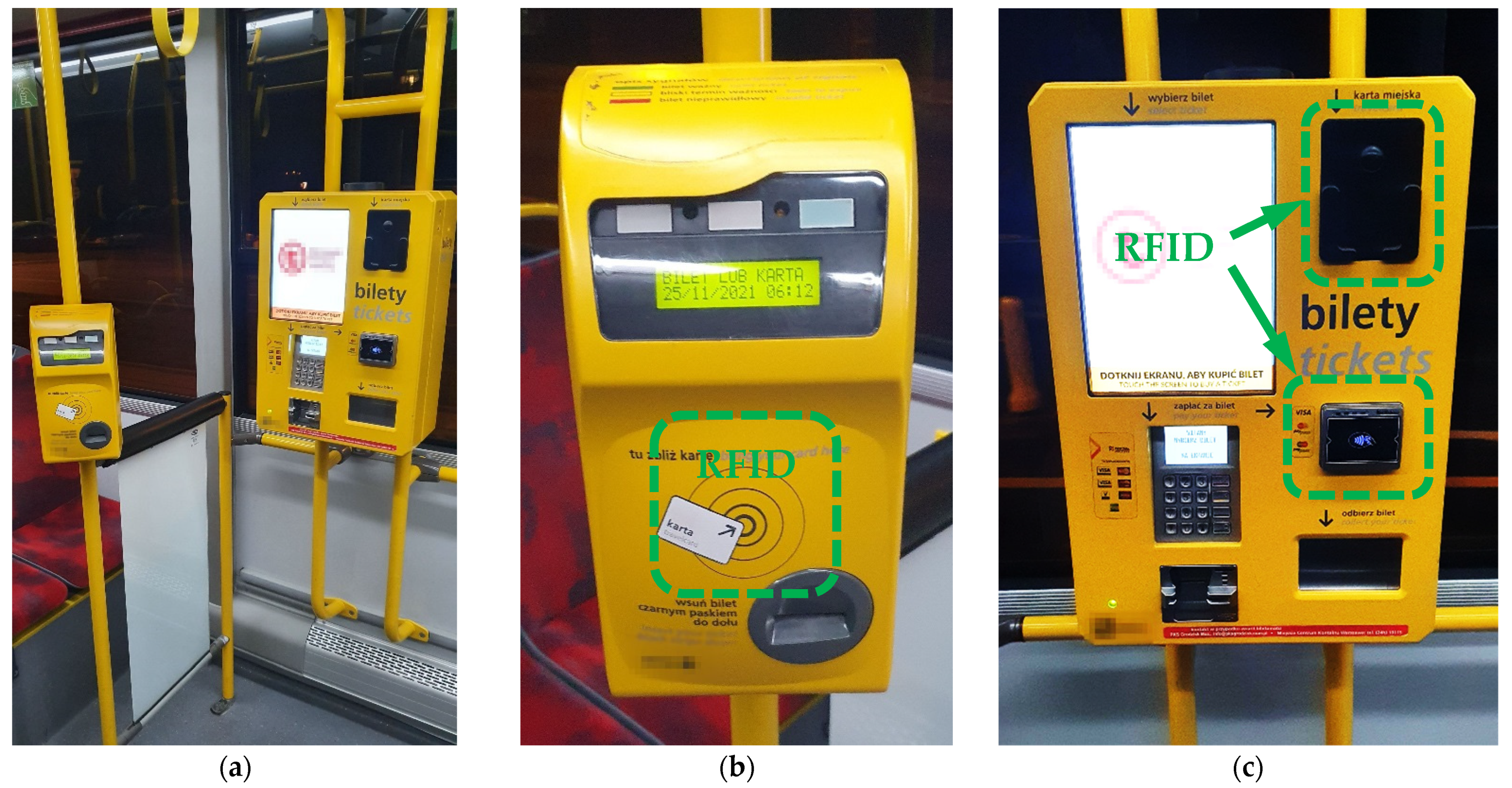


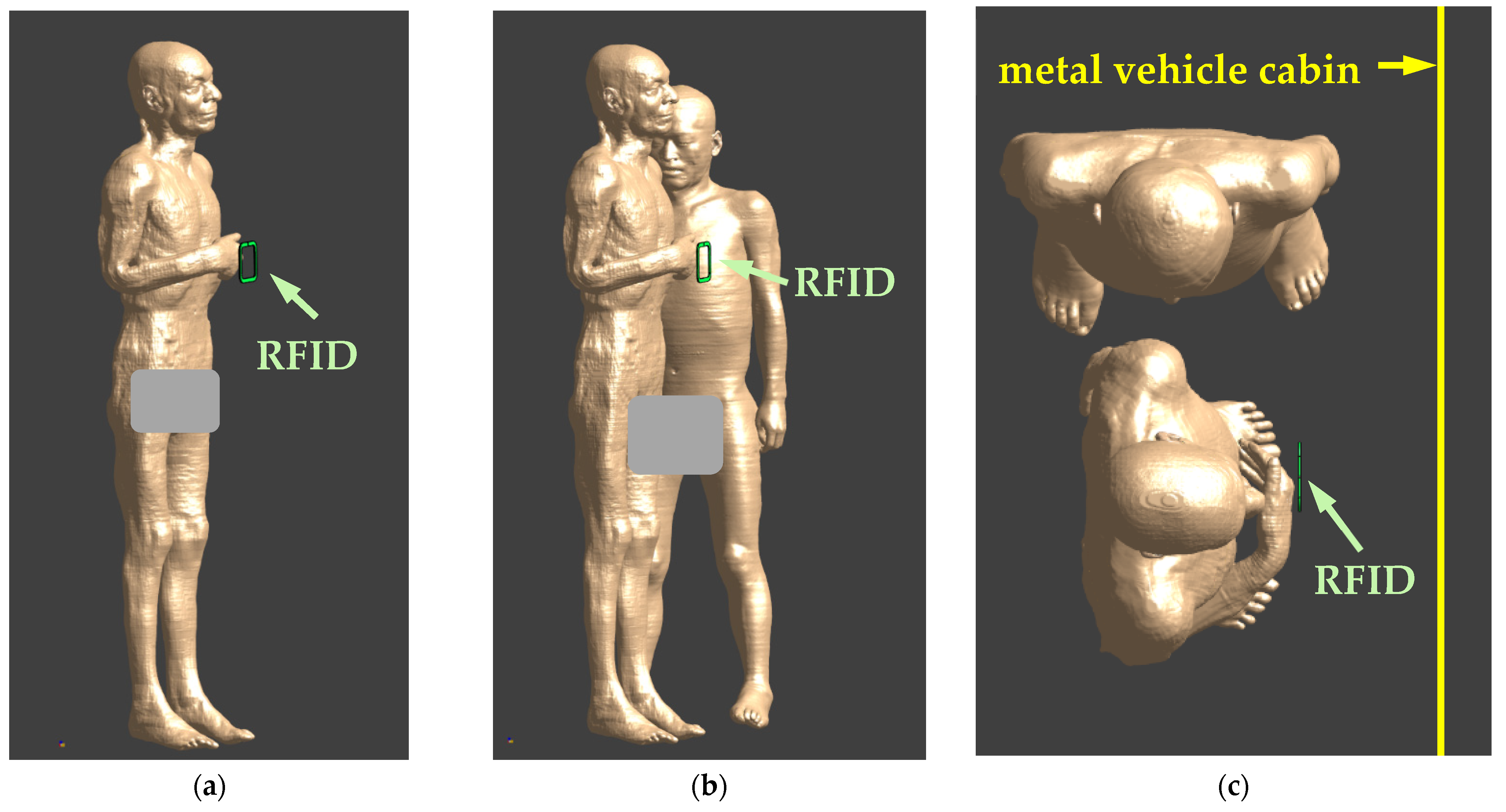

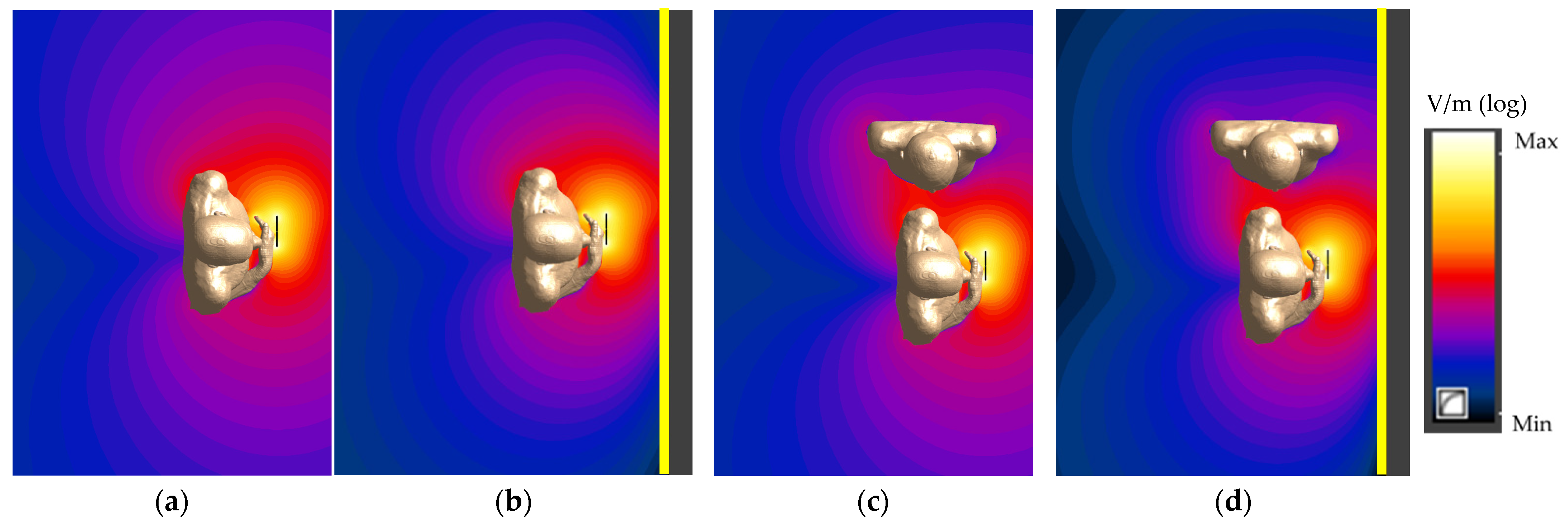
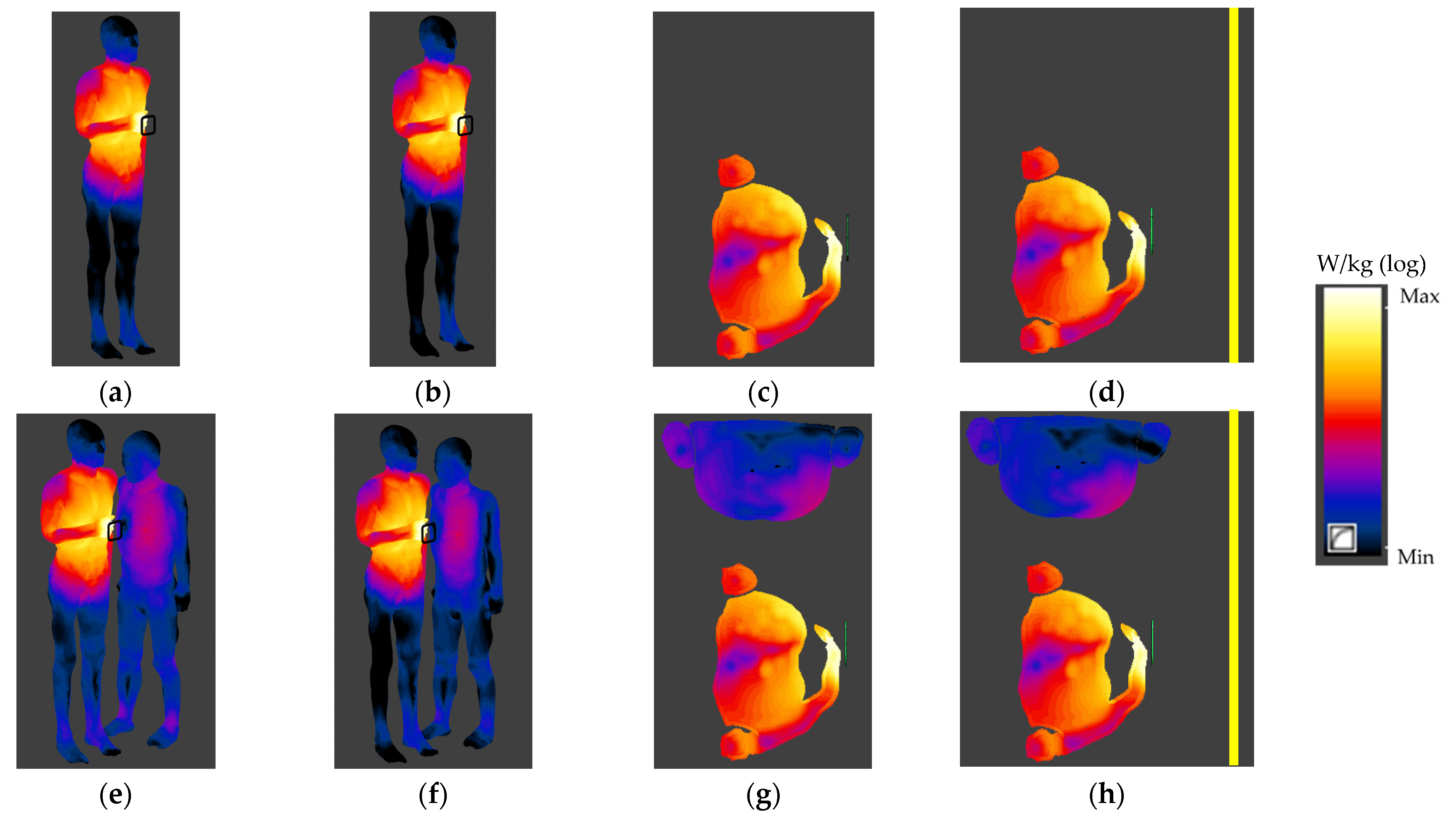
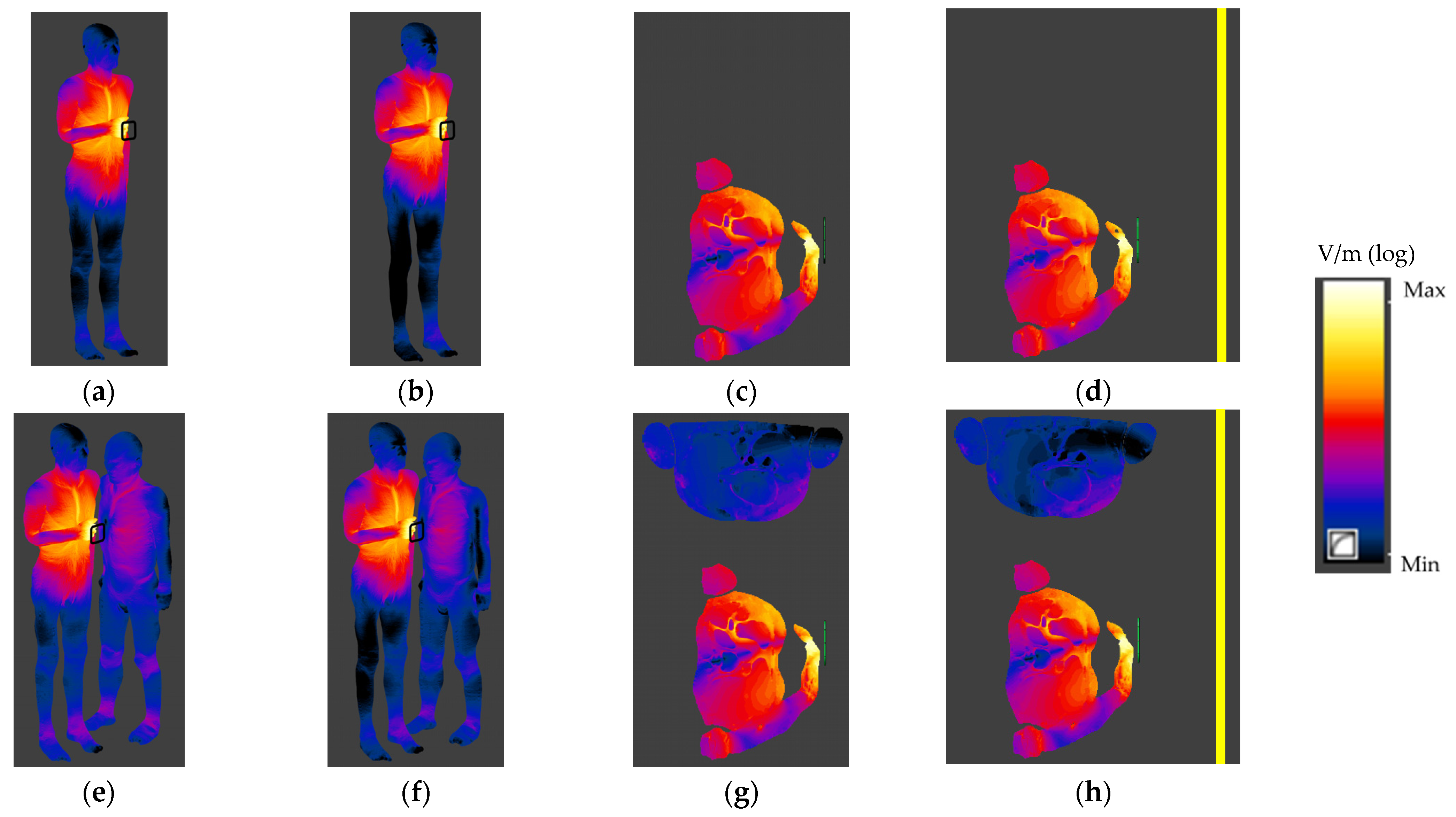
| Exposure Scenario | Magnetic Field Strength, mA/m | ||||||||
|---|---|---|---|---|---|---|---|---|---|
| Evaluation Points | |||||||||
| A1 | B1 | C1 | A2 | B2 | C2 | D | E | F | |
| Reader alone on vertical column | 7.0 | 41 | 12 | 7.0 | 41 | 12 | 8.0 | 8.0 | 1.1 |
| One person and reader on vertical column | 7.0 | 39 | 12 | 8.0 | 42 | 12 | 8.2 | 9.1 | 1.3 |
| Two persons and reader on vertical column | 7.3 | 42 | 12 | 7.1 | 42 | 12 | 8.2 | 9.0 | 1.3 |
| Reader alone attached to vehicle cabin | 5.1 | 38 | 17 | 5.1 | 38 | 17 | 10 | 10 | 1.0 |
| One person and reader attached to vehicle cabin | 5.3 | 35 | 17 | 5.5 | 38 | 17 | 11 | 12 | 1.0 |
| Two persons and reader attached to vehicle cabin | 5.3 | 37 | 17 | 5.3 | 38 | 17 | 11 | 11 | 1.1 |
| Exposure Scenario | Electric Field Strength, V/m | ||||||||
|---|---|---|---|---|---|---|---|---|---|
| Evaluation Points | |||||||||
| A1 | B1 | C1 | A2 | B2 | C2 | D | E | F | |
| Reader on vertical column | 0.23 | 1.0 | 0.60 | 0.23 | 1.0 | 0.60 | 0.55 | 0.38 | 0.11 |
| One person and reader on vertical column | 0.30 | 1.3 | 0.60 | 0.21 | 0.92 | 0.57 | 0.66 | 0.39 | 0.16 |
| Two persons and reader on vertical column | 0.80 | 2.3 | 0.49 | 0.22 | 0.93 | 0.53 | 0.70 | 0.47 | 0.22 |
| Reader alone attached to vehicle cabin | 0.17 | 0.92 | 0.37 | 0.17 | 0.92 | 0.37 | 0.28 | 0.19 | 0.046 |
| One person and reader attached to vehicle cabin | 0.22 | 1.1 | 0.31 | 0.16 | 0.79 | 0.29 | 0.37 | 0.27 | 0.079 |
| Two persons and reader attached to vehicle cabin | 0.51 | 1.8 | 0.57 | 0.15 | 0.79 | 0.28 | 0.50 | 0.30 | 0.11 |
| Exposure Scenario | Person under Exposure Evaluation | WBSAR 1, mW/kg | SAR10g 2, mW/kg | |
|---|---|---|---|---|
| Head/Torso | Limb | |||
| One person and reader on vertical column | PICC device user | 0.28 | 7.4 | 46 |
| Two persons and reader on vertical column | PICC device user | 0.28 | 7.4 | 46 |
| Bystander | 0.0024 | 0.070 | 0.060 | |
| One person and reader attached to vehicle cabin | PICC device user | 0.27 | 7.1 | 46 |
| Two persons and reader attached to vehicle cabin | PICC device user | 0.28 | 7.1 | 46 |
| Bystander | 0.0016 | 0.038 | 0.031 | |
| Exposure Scenario | Person under Exposure Evaluation | Ein ICNIRP 1, V/m | Ein IEEE 2, V/m | ||
|---|---|---|---|---|---|
| Peak | 99th Perc | Peak | 99th Perc | ||
| One person and reader on vertical column | PICC device user | 52 | 5.0 | 43 | 4.7 |
| Two persons and reader on vertical column | PICC device user | 55 | 5.1 | 49 | 4.8 |
| Bystander | 2.0 | 0.30 | 1.5 | 0.26 | |
| One person and reader attached to vehicle cabin | PICC device user | 52 | 5.0 | 43 | 4.3 |
| Two persons and reader attached to vehicle cabin | PICC device user | 55 | 5.0 | 49 | 4.7 |
| Bystander | 1.5 | 0.25 | 1.1 | 0.24 | |
| PICC Class 1 | RR, cm | WBSAR 2, mW/kg | SAR10g 3, mW/kg | Maximum RR When Exposure is Compliant with GP Limits 4, cm | |
|---|---|---|---|---|---|
| Head/Torso | Limb | ||||
| 1–3 | 4 | 0.0094 | 0.25 | 1.5 | 23 |
| 10 | 0.28 | 7.4 | 46 | ||
| 16 | 3.2 | 83 | 510 | ||
| 4 | 4 | 0.017 | 0.44 | 2.7 | 21 |
| 10 | 0.50 | 13 | 81 | ||
| 16 | 5.6 | 150 | 900 | ||
| 5 | 4 | 0.026 | 0.69 | 4.2 | 19 |
| 10 | 0.79 | 21 | 130 | ||
| 16 | 8.7 | 230 | 1400 | ||
| 6 | 4 | 0.085 | 2.2 | 140 | 15 |
| 10 | 2.5 | 6.7 | 410 | ||
| 16 | 28 | 740 | 4600 | ||
| PICC Class 1 | RR, cm | Ein ICNIRP 2, V/m | Ein IEEE 3, V/m | Maximum RR When Exposure is Compliant with GP Limits 4, cm | |||||
|---|---|---|---|---|---|---|---|---|---|
| Peak | 99th Perc | Peak | 99th Perc | ICNIRP Peak/99th Perc of Ein | IEEE Peak | ||||
| @10 MHz | @13.56 MHz | @5 MHz | @13.56 MHz | ||||||
| 1–3 | 4 | 10 | 0.93 | 8.9 | 0.87 | 32/72 | 36/80 | 46 | 63 |
| 10 | 55 | 5.1 | 49 | 4.8 | |||||
| 16 | 180 | 17 | 160 | 16 | |||||
| 4 | 4 | 13 | 1.2 | 12 | 1.2 | 29/66 | 32/75 | 40 | 58 |
| 10 | 73 | 6.8 | 65 | 6.3 | |||||
| 16 | 250 | 23 | 220 | 21 | |||||
| 5 | 4 | 17 | 1.5 | 15 | 1.5 | 27/61 | 30/65 | 38 | 53 |
| 10 | 92 | 8.4 | 81 | 7.9 | |||||
| 16 | 310 | 28 | 270 | 26 | |||||
| 6 | 4 | 30 | 2.8 | 27 | 2.6 | 22/50 | 25/55 | 31 | 42 |
| 10 | 170 | 15 | 150 | 14 | |||||
| 16 | 550 | 51 | 490 | 48 | |||||
Publisher’s Note: MDPI stays neutral with regard to jurisdictional claims in published maps and institutional affiliations. |
© 2022 by the author. Licensee MDPI, Basel, Switzerland. This article is an open access article distributed under the terms and conditions of the Creative Commons Attribution (CC BY) license (https://creativecommons.org/licenses/by/4.0/).
Share and Cite
Zradziński, P. Modelling and Evaluating Electromagnetic Field Exposure in the Multiple-Source Scenario of Using IoT HF RFID Readers. Int. J. Environ. Res. Public Health 2022, 19, 3274. https://doi.org/10.3390/ijerph19063274
Zradziński P. Modelling and Evaluating Electromagnetic Field Exposure in the Multiple-Source Scenario of Using IoT HF RFID Readers. International Journal of Environmental Research and Public Health. 2022; 19(6):3274. https://doi.org/10.3390/ijerph19063274
Chicago/Turabian StyleZradziński, Patryk. 2022. "Modelling and Evaluating Electromagnetic Field Exposure in the Multiple-Source Scenario of Using IoT HF RFID Readers" International Journal of Environmental Research and Public Health 19, no. 6: 3274. https://doi.org/10.3390/ijerph19063274
APA StyleZradziński, P. (2022). Modelling and Evaluating Electromagnetic Field Exposure in the Multiple-Source Scenario of Using IoT HF RFID Readers. International Journal of Environmental Research and Public Health, 19(6), 3274. https://doi.org/10.3390/ijerph19063274






